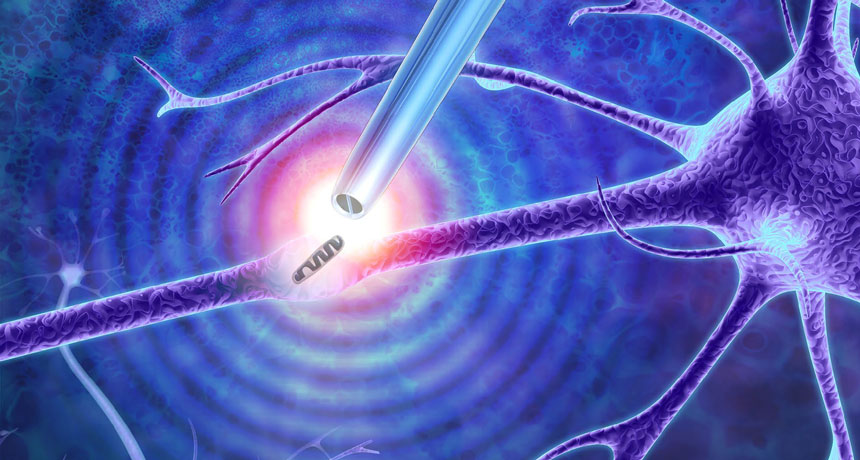Electro-tweezers let scientists safely probe cells
They allow repeated sampling of materials from the same living cell over time

These so-called tweezers can take out single molecules or structures from individual cells — such as mitochondria from nerve cells (illustrated here).
IMPERIAL COLLEGE LONDON
A new set of tools can pull individual molecules out of a living cell without killing it.
Think of it like a set of tweezers for use in the world’s smallest game of “Operation.”
Normally, sampling what’s in a cell requires breaking it open. “You basically kill the cell to get access,” says Orane Guillaume-Gentil. She did not work on the new device. This microbiologist at ETH Zurich in Switzerland is, however, familiar with the idea. With older tools, she points out, “It’s not possible to look at one cell and follow it over time.” It would be dead after the first look.
Because the new technique is so gentle, it can be used on the same cell over and over. That could show how a cell responds to growth or to things in its environment. And it might help people better understand how healthy cells work, and what goes wrong inside sick cells.
The researchers used their tweezers to extract molecules from different types of cells. First the team stained its cells with dyes. These glowed when the dyes glommed onto particular targets, such as DNA. Those target molecules would now stand out when researchers viewed them under a microscope. And that helped them guide their tweezers to extract the desired substance.
The researchers have removed DNA from human bone-cancer cells. They also entered human artery cells to nab messenger RNA. It’s a type of molecule that holds the instructions for building proteins. Extracting this mRNA from two different spots in a single cell, one hour apart, confirmed that the tweezers could be used to sample a cell more than once.
It’s electric!
Joshua Edel is a chemist at Imperial College London in England. Key to his group’s new tool is a sharp, glass rod. Its thin tip is less than 100 nanometers across. That’s about a tenth the diameter of a red blood cell. At the end of this rod are two electrodes. Each is made of a carbon-based material, such as graphite.
When Edel’s team applies an electric voltage to the tweezers, a powerful electric field develops around the electrodes. This attracts and traps small molecules within about 300 nanometers of the rod’s tip. Once in this electric net, molecules stay put until the voltage is turned off. Only then can the molecules drift away.
And these new tools can retrieve cargo bigger than a single molecule. For instance, mitochondria (My-toh-KON-dree-uh) are big structures in cells that convert nutrients into energy. Edel’s team used its nanotweezers to remove mitochondria from the nerve cells found in mouse brains.
So far, the researchers have only used their tweezers to operate on cells in petri dishes. But Edel says his team plans to test its pluckers on cells living inside growing tissues.
They described their nanotweezers online December 3 in Nature Nanotechnology.
This tool is “very powerful,” says Pak Kin Wong. He’s a biomedical engineer at Pennsylvania State University, in State College. Indeed, he notes, the new tool should make it possible to get a more detailed view of what goes on inside cells. For instance, plucking proteins and other stuff from different parts of a cell might highlight what role each plays.
Alexandra-Chloe Villani works in Cambridge, Mass. There, she studies genomics and immunology at Massachusetts General Hospital and the Broad Institute of MIT and Harvard. She believes these gentle tools might one day help in projects like the Human Cell Atlas. It aims to create unique “ID” cards for each type of cell in the human body. Each ID would describe how a particular type of cell works.
Sampling DNA from different cells might help researchers also search for random changes in genes known as mutations, Edel says. Those mutations might underlie different diseases.
Monitoring the molecular makeup of cells over time also could reveal how cells are affected by illnesses or respond to new drugs, adds Guillaume-Gentil.
This is one in a series presenting news on technology and innovation, made possible with generous support from the Lemelson Foundation.







